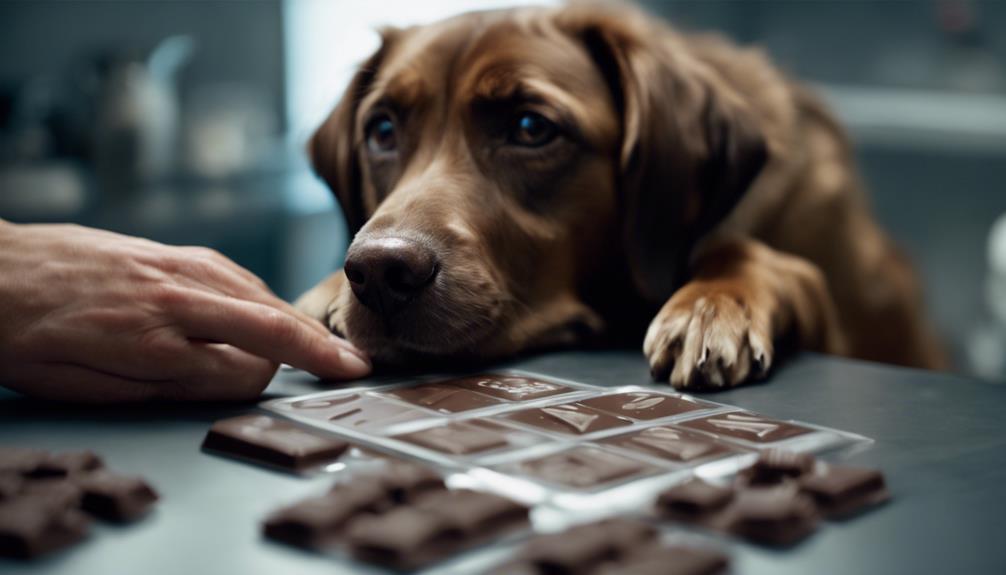How Many Ounces of Dark Chocolate Can a Dog Eat
As a dog owner, I must be vigilant about dark chocolate. Even a few ounces can be harmful due to the theobromine it contains. Understanding this risk is important to protecting my furry friend. Remember, it's essential to think about the dangers before letting your dog consume any dark chocolate.
Key Takeaways
- The amount of dark chocolate a dog can eat depends on its size, weight, and sensitivity to theobromine.
- Small dogs are more vulnerable to the toxic effects of theobromine in dark chocolate.
- It is best to avoid feeding any amount of dark chocolate to dogs due to the risks involved.
- Even small amounts of dark chocolate can be harmful and potentially toxic to dogs.
- Immediate veterinary care is necessary if a dog ingests any amount of dark chocolate.
Dark Chocolate and Dogs: Understanding the Risks

Dark chocolate poses serious risks to dogs due to its high levels of theobromine, which can be toxic to them. As a dog owner, it's important to understand that theobromine, a stimulant similar to caffeine, affects dogs differently than humans.
Even small amounts of dark chocolate can lead to symptoms like vomiting, diarrhea, rapid breathing, increased heart rate, and even seizures in dogs. It's necessary to keep dark chocolate out of reach from our furry friends, as their bodies metabolize theobromine much slower than humans.
If you suspect your dog has ingested dark chocolate, it's crucial to contact your veterinarian immediately for guidance and potential treatment to prevent any serious health complications.
The Toxicity of Theobromine in Dark Chocolate
The toxicity of theobromine in dark chocolate can be highly harmful to dogs.
It's important to be aware of the levels of theobromine in chocolate, as even small amounts can lead to symptoms of poisoning.
If a dog shows signs of theobromine toxicity, prompt treatment is necessary to prevent serious consequences.
Theobromine's Toxicity Levels
Understanding the toxicity levels of theobromine in chocolate is vital for pet owners to ensure their dogs' safety. Theobromine, a stimulant found in chocolate, can be toxic to dogs in certain quantities. It affects dogs differently based on their size, age, and overall health.
Dark chocolate contains higher levels of theobromine compared to milk chocolate, making it more dangerous for dogs. Even small amounts of dark chocolate can lead to theobromine poisoning in dogs. The toxicity levels vary depending on the dog's weight, but as a general rule, the smaller the dog, the more dangerous even small amounts of dark chocolate can be.
It's important to be aware of the theobromine levels in different types of chocolate to prevent accidental poisoning in dogs.
Symptoms of Theobromine Poisoning
Symptoms of theobromine poisoning in dogs can manifest in various ways, indicating the significance of this compound found in dark chocolate. Initially, a dog may show signs of restlessness, increased heart rate, and excessive panting.
As the theobromine levels accumulate in the body, more severe symptoms like vomiting, diarrhea, muscle tremors, and seizures can occur. These signs typically start to show within 6-12 hours of ingestion and can last for up to 72 hours.
In severe cases, theobromine poisoning can lead to high blood pressure, rapid breathing, cardiac arrhythmias, and even death. It's vital to monitor your dog for these symptoms if they've ingested dark chocolate and seek immediate veterinary care to prevent further complications.
Treatment for Theobromine Toxicity
Upon detecting the symptoms of theobromine poisoning in your dog, timely and essential treatment is important to counteract the toxicity of theobromine found in dark chocolate. When dealing with theobromine toxicity, here are some key steps to keep in mind:
- Inducing Vomiting: This can help remove the chocolate from the stomach.
- Activated Charcoal Administration: It can help prevent further absorption of theobromine into the bloodstream.
- Intravenous Fluids: Ensuring adequate hydration is crucial for supporting kidney function.
- Monitoring Heart Rate: Theobromine can affect the heart, so keeping an eye on this is essential.
- Consulting a Veterinarian: Professional guidance is necessary for tailored treatment based on the dog's condition.
Factors Affecting Dark Chocolate Toxicity in Dogs
After consuming dark chocolate, various factors can influence the level of toxicity experienced by dogs. The size and weight of the dog play a significant role, as smaller dogs are more susceptible to the effects of theobromine.
Additionally, the amount of chocolate ingested is important, as higher quantities contain more theobromine, leading to increased toxicity.
The type of chocolate matters too, with dark chocolate containing higher levels of theobromine compared to milk or white chocolate. Age also plays a role, as younger dogs may be more sensitive to theobromine.
Moreover, individual sensitivity varies among dogs, with some being more tolerant to theobromine than others. Understanding these factors is essential in evaluating the risk and potential toxicity of dark chocolate ingestion in dogs.
Safe Amounts of Dark Chocolate for Dogs

When determining safe amounts of dark chocolate for dogs, it's crucial to take into account their size and theobromine sensitivity. Dogs vary greatly in size and metabolism, which influences how they process theobromine. Here are some key points to bear in mind:
- Breed Differences: Different dog breeds can have varying levels of theobromine sensitivity.
- Body Weight: Heavier dogs can generally tolerate more theobromine compared to smaller dogs.
- Chocolate Type: Dark chocolate contains higher theobromine levels than milk chocolate.
- Health Condition: Dogs with certain health conditions may be more sensitive to theobromine.
- Individual Sensitivity: Each dog may react differently to the same amount of theobromine.
Symptoms of Dark Chocolate Poisoning in Dogs
Considering the potential risks associated with dark chocolate consumption in dogs, recognizing the symptoms of dark chocolate poisoning is vital for prompt intervention. Symptoms of dark chocolate toxicity in dogs typically include vomiting, diarrhea, increased thirst, restlessness, rapid breathing, elevated heart rate, muscle tremors, seizures, and potentially fatal complications like cardiac arrhythmias.
It's important to be vigilant for signs of chocolate poisoning, especially if a dog has ingested a substantial amount of dark chocolate. Monitoring for these symptoms and seeking immediate veterinary care if any are present can greatly improve the chances of a positive outcome. Remember, swift action is key in treating dark chocolate poisoning in dogs.
Treatment for Dark Chocolate Toxicity in Dogs

Prompt veterinary intervention is essential in treating dark chocolate toxicity in dogs. Upon ingestion, immediate actions by a professional can be life-saving. The treatment plan may involve inducing vomiting, administering activated charcoal to prevent further absorption, and providing supportive care such as intravenous fluids. In severe cases, medications to control symptoms like seizures or abnormal heart rhythms might be necessary. Additionally, monitoring the dog's blood pressure, body temperature, and organ function is critical for a successful recovery.
- Inducing vomiting to remove the chocolate from the stomach.
- Administering activated charcoal to prevent further absorption.
- Providing intravenous fluids for hydration and toxin elimination.
- Using medications to control symptoms like seizures or abnormal heart rhythms.
- Monitoring vital signs and organ function closely throughout the treatment process.
Preventing Dark Chocolate Ingestion in Dogs
To prevent dark chocolate ingestion in dogs, it's important to store all chocolate products out of their reach. Dogs have a keen sense of smell and are naturally curious, making it vital to secure chocolate in cabinets or high shelves. Remember that different types of chocolate contain varying levels of theobromine, which is toxic to dogs.
Be mindful of where you leave chocolate treats, baking ingredients, or even cocoa powder. Additionally, educate family members and guests about the dangers of giving chocolate to dogs. By being proactive and diligent in keeping chocolate inaccessible to your furry friend, you can greatly reduce the risk of accidental ingestion and potential poisoning.
Conclusion: Keeping Your Dog Safe From Dark Chocolate

I'll wrap up by highlighting the key points to remember when it comes to keeping your dog safe from dark chocolate:
- Be mindful of the safe chocolate amount.
- Watch out for symptoms of toxicity like vomiting or seizures.
- Always have your emergency vet contact handy in case of an incident.
Safe Chocolate Amount
Understanding the safe amount of dark chocolate that dogs can consume is important for keeping your furry friend out of harm's way. It's essential to be mindful of how much dark chocolate you expose your dog to. Here are some key points to keep in mind:
- Even small amounts of dark chocolate can be toxic to dogs.
- The theobromine content in dark chocolate is harmful to dogs.
- Different dogs may have varying levels of sensitivity to chocolate.
- It's best to completely avoid feeding dark chocolate to your dog.
- In case of accidental ingestion, contact your veterinarian immediately.
Symptoms of Toxicity
Even a small amount of dark chocolate can trigger toxic symptoms in dogs, making it important to recognize the signs of chocolate poisoning to keep your furry friend safe. Some common symptoms of chocolate toxicity in dogs include vomiting, diarrhea, increased thirst, restlessness, elevated heart rate, muscle tremors, seizures, and in severe cases, even death. If you notice any of these signs after your dog has ingested dark chocolate, it is essential to seek immediate veterinary care. Remember that the severity of symptoms can vary based on the amount and type of chocolate consumed, as well as the size and health of your dog. Being vigilant and proactive can help prevent a potentially dangerous situation.
| Symptoms | Description |
|---|---|
| Vomiting | Forceful emptying of stomach |
| Diarrhea | Loose or watery stool |
| Increased thirst | Excessive need for water |
| Restlessness | Unable to relax |
| Elevated heart rate | Faster than normal heart rate |
Emergency Vet Contact
In case of a dark chocolate emergency with your dog, make sure you have the contact information for an emergency vet readily available. If your furry friend ingests dark chocolate, time is important. Here are some essential steps to take:
- Contact the Emergency Vet: Call the emergency vet immediately for guidance.
- Provide Information: Share details such as the type and amount of chocolate ingested.
- Follow Instructions: Follow the vet's advice precisely to help your dog.
- Monitor Closely: Keep a close eye on your dog's symptoms and behavior.
- Transport Safely: Safely transport your dog to the vet if instructed to do so.
Being prepared and acting promptly can make a significant difference in ensuring your dog's well-being.
Conclusion
In summary, it's important to keep dark chocolate away from your furry friend to prevent potential poisoning.
Even a small amount can be toxic to dogs due to the presence of theobromine.
Be vigilant and always store dark chocolate out of reach to guarantee the safety and well-being of your beloved pet.
Remember, when it comes to dark chocolate and dogs, it's better to be safe than sorry.

If Richie Bedard is a dog food expert, author, or any other figure in the field of dog nutrition that emerged after September 2021,






